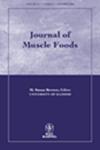The study was aimed at optimizing the post package reheating (pasteurization) hurdle for processing shelf stable pork sausages. The temperatures evaluated were 80, 90 and 100C. Reheating resulted in an increase in pH, which was slight at 80C while significant (P < 0.05) at 90 and 100C. Moisture and fat contents decreased significantly while protein content increased significantly with increase in reheating temperature. Reheating of the sausages up to 90C significantly improved their hardness and shear force values. Reheating to 90 and 100C increased the redness (a-values) and decreased yellowness (b-values) of the sausages. Despite a lower initial value, the pH of the control sausages increased by 0.3 units on day 3 of storage, while that of reheated samples showed only a slight increase (0.04–0.05 units). About 10 times increase (0.05–0.50) in thiobarbituric acid reacting substances values observed for control sausages during 3 days storage at ambient temperature (37 ± 1C) while the increase in reheated samples was significantly (P < 0.01) lower. Total plate counts reached about 7 log cfu/g on day 3 of storage in control sausages, but it took about 9 days and 12 days, respectively, for those reheated to 80 and 90C and 100C. Post package reheating of pork sausages resulted in initial reduction in most of the sensory attributes, but helped to maintain these attributes for longer time during storage at 37 ± 1C and the sausages subjected to 90C maintained higher overall acceptability compared to other treatments throughout the storage period of 12 days.
Development of a meat product that could be stored at ambient temperature will save the expenses on refrigeration energy and cooler space requirement which is of importance in developing countries, where electricity is a major problem. Further, the successfully evolved process can be tried for developing different shelf stable meat products with other meats.


